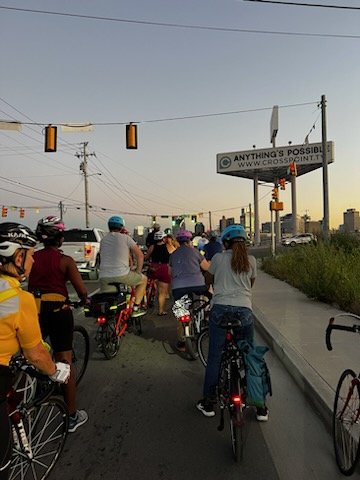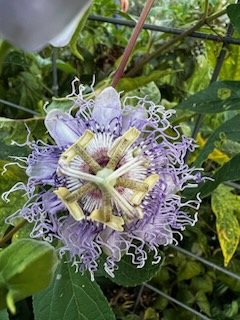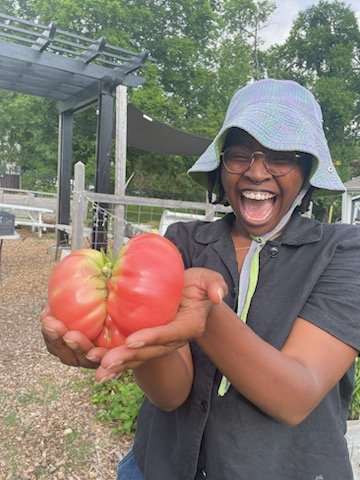Green Pedals: Urban Gardens Civic Tour
By Nia Smith, Community Design Coordinator
8 min read On August 31st, the Civic Design Center hosted a civic tour on bikes around 4 different urban gardens. This blog explores the connection between green spaces and green infrastructure and reflects on the experience.
On August 31, we were joined by enthusiastic people for a bike tour around the city to 4 community gardens within a 15 mile radius of each other. The route was just under 13 miles, just over 3 hours, with stops in Cumberland Heights, North Nashville, and Downtown! Riders faced bumpy gray infrastructure, tight bikeways and tricky sharrows to arrive at lush, beautiful community managed green spaces sprinkled throughout the city.
The group assembles at the Civic Design Center before heading out on the ride
Making Health Accessible
Quick facts about the importance of protecting Nashville’s green spaces
Mass bike rides make unsafe gray infrastructure, like car-dominant roads and bridges, much easier to ride, as bikers can travel in a pack and are more visible. Not to mention, bike rides are a great way to become familiar with the city, its landscape and other natural environments. Streets aren’t just for cars! Mass rides remind us that we all have a right to the street and we can celebrate them as places that address neighborhood needs.
We chose to bike to visit each garden because it allowed for the most accessibility, especially encouraging people to give biking a chance. Biking is a great opportunity to talk with neighbors about what they see around them and how it feels to exist on the roads. B-Cycle provided passes for the ride to people who didn’t have bikes, wanted to test out a pedal-assist e-bike, or knew that it would be the best bike for a cross city commute. Nate with Music City Dope Pedalers, a weekly community bike riding group, was pivotal in improving the route’s accessibility.
Biking also allowed us to alleviate our impact on the environment’s natural resources and test out bike infrastructure across Nashville. The bike lanes on DB Todd and Buchanan/Garfield, sharing the road on Jefferson St and Cowan St, even the future bike network on 10th Ave Downtown. The ride was quite bumpy in spots and since these are the roads cyclists are expected to share with cars, the volume of which can handle such aggressive shocks to their vehicle, there is little motivation to improve them.
Bikers prepare to ride starting in Downtown Nashville
At Brooklyn Heights Community Garden, Ashley Brailsford shares the history of the garden with attendees
Considering our Guiding Principle, “health-promoting features that responded to neighborhood attributes,” we thought a community ride with intentional garden stops would provide an added exploration of this principle. Biking is one of the healthiest and most accessible ways to get around. Together, we explored how accessible fresh food can be by bike. This Civic Tour also provided an opportunity to address the food apartheids, low-income areas that have been purposely under-resourced as part of the global food chain, across Nashville. At the stops, community members could learn about the availability of urban garden plots and how to grow and prepare healthy meals.
“Using the term “apartheid” focuses our examination on the intersectional root causes that created low-income and low food access areas, and importantly, points us towards working for structural change to address these root causes.”
- Natural Resource Defense Fund
Fast farm facts from Nashville Open Space Plan
Addressing Food Apartheids
Across the country, farmland is being purchased at a massive rate by corporations and billionaires who want to have a greater market share of our food supply. As the planet’s temperature rises and crop failure becomes more prevalent, it becomes far less possible for smaller farmers to maintain their farmland. It also becomes harder for us to have control over our food supply and access. This is especially true for marginalized communities.
Due to historically racist federal loan practices, Black farmers were denied access to loans for land and supplies. Their lands would be taken away by the state or wealthier landowners who could use difficult legal language and bureaucracy to their advantage. Even today, the USDA has still failed to pay out the $1.2 billion racial discrimination settlement to Black farmers. Despite Black labor building the agricultural wealth of the US, they are often the last group to reap such rewards. Today, migrant workers work on farms nationally for inequitable pay and poor labor conditions. According to the USDA, in 2021 farming accounts for 1.3% of labor in the US. A reduction in equitable farmers across the country has a detrimental impact on our food supply. President Roosevelt included a farmer’s right to a fair income as part of his second bill of rights, recognizing that our farmers keep our country fed.
Community gardens can’t undo history or the trajectory of a capitalist nation. However, they fill so many gaps in our urban ecosystem. First and foremost, they can provide valuable planting and farming education to people who would not otherwise have access, empowering people to provide their own fresh food in food apartheids. From a community design point of view, community gardens can create vital green spaces in heat islands, they can provide a third space for people to gather and spend time together[1] [2] [3]. And like biking, gardening is a grounding and reenergizing exercise that empowers us to be present our physicality. There is nothing more fulfilling than a tomato sandwich from tomatoes you grew![4]
Another Guiding Principle of note is, “strengthen the unique identities of neighborhoods that reflects their people, history, and culture.” Community gardens directly work towards this Principle; they allow us to take ownership of our neighborhoods and provide neighbors with the opportunity to steward green spaces. Community gardens are a huge responsibility, but they offer deeper connection to place. Immigrant populations can grow the fruits and vegetables that connect them to home, and native Nashvillians can plant fruit trees and perennials that represent their neighborhood’s natural environment. Regardless, community gardens allow us to bring all kinds of plant life back into our communities and ultimately improve the quality of life for all.
What Does it Mean to be the Greenest City in the South?
Recommendations have been laid out by the Green Ribbon Committee, who produced Together Making Nashville Green in 2009. Encouragingly, there is a planned strategy for a city-wide Urban Agriculture! Hiring full-time Urban Agricultural Specialists would set us on the path. These Specialists could coordinate the distribution of donated garden goods to food banks and other community groups. The committee also recommends planting edible plants throughout Nashville and encouraging sustainable landscaping. Websites like the Fallen Fruit feature hand-drawn maps of edible fruits in neighborhoods, and a database for edible fruit trees across the world. There already are some parks in Nashville that have edible trees. We encourage you to view the map examples above and make one for your neighborhood, or simply get inspired to plant a fruit tree.
A neighborhood map of edible trees in Sweden
Together Making Nashville Green puts great focus on improving the quality of fresh and healthy food given to youth in Nashville by incorporating local farms and gardens in Metro School cafeterias. Such programs can encourage a knowledge of nutrition and strengthen relationships to food at a young age. The farm season runs in part with the school year and can be not only a hands-on learning opportunity, but a legitimate way to address youth hunger in our city.
Nashville Open Space Plan continues with a goal to triple the number of farms selling direct to customers in Davidson County on the same 5-year timeline mentioned above. Community Supported Agriculture (CSA) programs are also a great way to secure customers directly for farmers. The recommendations from Together Making Nashville Green include working with Metro to remove zoning barriers in neighborhoods for CSA drop offs and farmer’s markets. These efforts can mitigate the effects of food apartheids and promote community-supported, local economies to be equitable and sustainable.
These recommendations are over a decade old, but they do not feel any less timely. The Nashville Open Space Plan does not merely provide goals for urban garden spaces and preserving Davidson County farmland. The plan emphasizes the need for connectivity between all of Nashville’s prestigious green spaces, likening them to “pearls on the necklace”, and stating that people should be able to travel from one end of county to the next solely by greenways and bikeways. This vision of connectivity is exactly what we hoped to encourage with the Green Pedals ride! We encourage you to read some of the green space plans referenced in this article and linked below. Do they still match your vision for the city? Would you like to have more urban gardens in your neighborhood? How would it feel to have a robust biking network connecting all of Nashville’s neighborhoods?
gardening and Biking United
“In conversations with community gardeners, one consistent theme emerges: for a community garden to succeed, there must be a committed individual or crew to shepherd the project through an entire growing season, from the early excitement of spring planting through the sweltering labors of summer maintenance.”
This quote comes from our publication, Shaping Healthy Communities, and articulates a very important point about community managed spaces. They require our constant, sustained effort to succeed. Like farming and gardening, biking across the city takes considerable amounts of effort. They both require communal support and can only improve when we all work together to improve them. Civic participation requires our collective willpower and effort. Take note of rough infrastructure or changes that could make riding a bike more comfortable. You can submit a ticket through hubNashville for everything that needs to fixed. Identifying places in need of repair and action can improve multi-modality and access for even the most vulnerable.
In order to find the nearest community gardens to you, check out the agriculture map produced by the State of Tennessee and the more comprehensive Garden Locator by Trap Gardens. We recommend visiting several community gardens and participating for at least a season before embarking on your own.
Additional reading:
Nashville Open Space Plan : Nashville Naturally Report
Seeding Spaces: Civic Design Center Report
Together Making Nashville Green: Green Ribbon Committee Report












